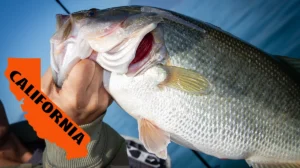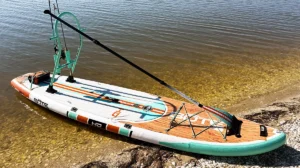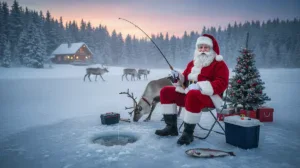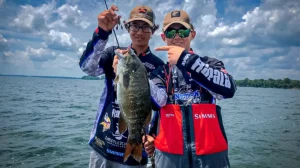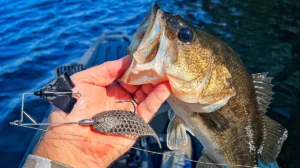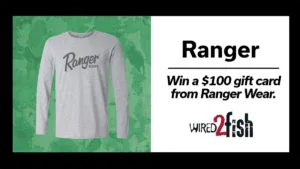Professional angler Gerald Swindle keeps his soft plastic selection very simple when targeting summer bass. While many anglers experiment with bizarre shapes and inventive colors when the bite gets tough, Swindle quotes a popular viral video when he says, “Ain’t nobody got time for that!”
Embracing simplicity has paid big dividends for Swindle. While he certainly sees the occasional need to switch things up and think outside the box, utilizing these 5 specific shapes and profiles have allowed him to master specific techniques and catch a lot of big summer bass.
1. Big ribbontail worm
- Hook: 5/0 Lazer Trokar HD Worm Hook
- Weight: 1/2-ounce tungsten
- Imitates: Leeches and snakes
- Favorite Color: Plum Apple
When targeting bass around deep cover or structure, Swindle is a big believer in the Zoom Ol Monster Worm. Although a lot of anglers tend to overlook this classic shape, he keeps one rigged up throughout the entire summer.
“The Ol’ Monster has been around forever and people forget the power of it,” Swindle said. “Big worms really start to shine right after the spawn as post-spawners leave the flats in favor of deeper water. This bad boy doesn’t take any prisoners—its big ribbon tail fools big bass, small bass and everything in between.”
As the water temperature reaches the 72 to 74-degree range, Swindle has noticed enormous deep water leech hatches on many lakes, including his home fishery of Lake Guntersville. Throughout May and June, he catches a lot of bass adorned with leeches exceeding 10 inches in length. This may be the secret behind the effectiveness of the Ol’ Monster.
“I know a lot of guys think an Ol’ Monster imitates a snake—I’m sure it does, but I really think these leech hatches are what makes big worms so attractive to summer bass,” Swindle said. “The hatches tend to take place in 10 to 15 feet of water and big bass will devour them.”
2. Soft jerkbait
- Hook: 4/0 Lazer Trokar EWG Worm Hook
- Weight: 1/2-ounce Scrounger Jig Head or Fish Head Spin, weightless
- Imitates: Active, schooling shad
- Favorite Color: Albino
If G-Man notices summertime bass aggressively feeding on shad, it’s hard to pry a Zoom Super Fluke out of his hand. Whether he has it rigged on a Scrounger Jig Head or a Fish Head Spin, he’s always ready to cast one toward schooling bass.
“Super Flukes mimic baitfish extremely well because of their gliding, darting action,” Swindle said. “It seems like you’re always going to run into a school of active bass while you’re on the water, and I haven’t found a better way to catch them than with a Super Fluke. That’s some of the most fun you can possibly have.”
3. Slow sinking worm
- Hook: 3/0 Lazer Trokar HD Worm Hook or 4/0 Lazer Trokar EWG Worm Hook for weightless
- Weight: 1/2-ounce tungsten for Carolina rig, 1/8 or 1/4-ounce for shaky head
- Imitates: Lethargic shad
- Favorite Colors: Red Bug, Green Pumpkin
As the summer heat intensifies and the bite begins to slow, a Zoom Trick Worm becomes a heavy hitter in Swindle’s arsenal. While he throws the Super Fluke to fool bass feeding aggressively on shad, he relies on the Trick Worm to coerce lethargic shad feeders into biting. Its versatility proves invaluable for Swindle.
“A man simply can’t go wrong with a Trick Worm,” Swindle said. “You can Texas and Carolina rig it to fish deep brush piles, rig it weightless if you’re targeting shallow cover and put it on a 1/8 or 1/4-ounce shaky head to catch spooky, clear water fish. You can do just about anything with it.”
Perhaps his favorite time to use a Trick Worm is when he’s targeting pressured fish. As bass get bombarded throughout summer weekends with every bait known to man, Swindle breaks out a shaky head and Trick Worm combo and goes to town. He catches some of his biggest bass this way.
“People think you can’t catch big bass on a shaky head,” Swindle said. “I’d have to disagree on that one. Sometimes you have to really downsize to fool big, smart bass and this rig is the way to do it.”
4. Creature bait
- Hook: 4/0 Lazer Trokar Flippin Hook
- Weight: 1-ounce tungsten for matted grass, 5/16 or 1/4-ounce tungsten for everything else
- Imitates: Bream, crawfish
- Favorite Color: Watermelon Candy with chartreuse-dyed tail
There’s not a better grass flipping and punching bait than the Zoom Z Hog, according to Swindle. When matted vegetation is prevalent in the middle of summer, he uses a Z Hog Jr to pluck big bass from underneath the thick grass.
“I’ve found the Z Hog Junior to be outstanding in heavy vegetation because in areas where a 1 1/2-ounce tungsten weight is needed to get bulkier baits through the cover, the Z Hog Jr can get through with just a 1-ounce weight,” Swindle said. “Downsizing your weight is a good thing in the summer because it allows for a more natural presentation.”
Although the Z Hog Junior is compact, it’s still big enough to rig on a 4/0 hook. With so much hook in the bait, Swindle notices better hookups and fewer lost opportunities.
“You don’t get much nipping and leg-grabbing with this bait,” Swindle said. “If a bass tries to come over and play with it, there’s a very good chance you’ll get a good hook in him.”
5. Subtle swimbait
- Hook: 3/0 or 4/0 jig head hook
- Weight: 1/2 or 3/8-ounce
- Imitates: Deep, schooling shad
- Favorite Colors: White Ice, Arkansas Shad
When a crankbait can’t get deep enough, Swindle catches a lot of ultra-deep bass on a Zoom Swimmin Super Fluke. After seeing bass suspended under deep bait balls on his Humminbird, he uses a yoyo retrieve when working the Swimmin Fluke through the school.
“When fish get really deep on shell bars or underneath shad, I rig my Swimmin Super Fluke on a 1/2-ounce jig head and can reach fish that a crankbait can’t,” Swindle said. “I’ll either yoyo it on a tight line or slowly reel it through suspended schools—they’ll almost rip the rod out of your hands when they hit it.”
Not only will the Swimmin Super Fluke reach depths most crankbaits can’t, but it also gives bass a different profile than they’re used to seeing. After months of watching deep crankbaits swim by, they’re quick to nab something with a different, more subtle profile.
Soft plastic selection doesn’t have to be stressful or overwhelming. To master more techniques and maximize your fishing time, try simplifying your selections. It helps G-Man catch more fish, so give it a try next time you’re on the water.






